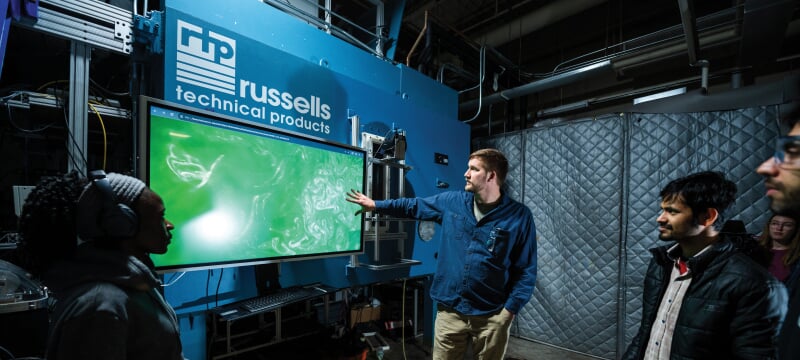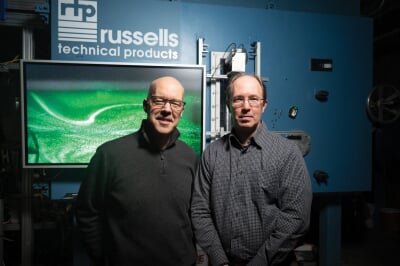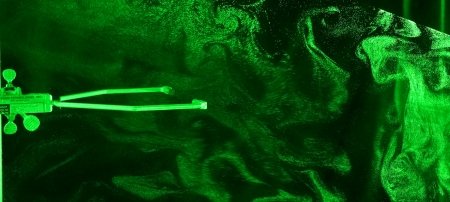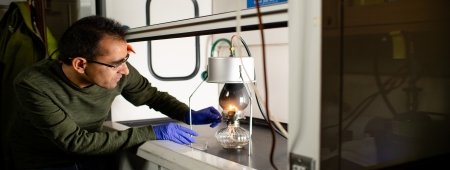Michigan Tech's Pi Cloud Chamber is giving researchers unique insight into cloud formation and behavior, positioning the University at the forefront of atmospheric research and climate science.
The sky above us often feels like a mystery—a place where clouds form, change, and sometimes disappear. However, at Michigan Tech, researchers are bringing this mystery down to Earth. In the Pi Cloud Chamber, one of the world's most advanced cloud simulation facilities, they are uncovering how clouds behave and evolve, and how we might influence them.
Inside the Pi Cloud Chamber, the atmospheric forces that drive cloud dynamics are brought into focus, offering researchers a deeper understanding of their formation and evolution. The chamber can simulate a broad range of atmospheric conditions, including temperature shifts and aerosol concentrations, making it an ideal environment for controlled experimentation.
Researchers Will Cantrell, Raymond Shaw, and a team of postdoctoral researchers and graduate students are using this cutting-edge facility to explore cloud seeding, the formation of cloud droplets, and the elusive birth zones of clouds. In addition, the Pi Cloud Chamber has become a hub for international collaborative studies on aerosol-cloud interactions in a controlled environment, attracting researchers from across the globe. Their work provides profound insights into how clouds affect everything, from localized weather patterns to global climate change.
Making it Rain
In the dry, arid regions of the world, the promise of rain is often fleeting. However, Cantrell is working on something that could change that: cloud seeding. Supported by the Rain Enhancement Program of the United Arab Emirates, Cantrell's research aims to understand how introducing particles into clouds might encourage precipitation, offering a potential lifeline to regions desperate for water.
Cantrell, who has spent years studying cloud formation, sees cloud seeding as a natural evolution of his work. "Every cloud droplet in Earth's atmosphere initially condenses on a preexisting particle," he says. "Cloud seeding is simply the idea that we can put particles into clouds that may speed up or enhance the processes that lead to precipitation." This work has the potential to provide regions facing water scarcity with more control over rainfall. The implications extend far beyond just water resources, influencing agriculture, sustaining ecosystems, and boosting local economies that depend on consistent rainfall.
Unlike the constantly changing conditions of the natural world, the Pi Cloud Chamber gives Cantrell and his team the unique ability to control conditions, run experiments, and observe how droplets form in a repeatable environment. "The Pi Cloud Chamber allows us to investigate aspects of the problem in a way that isn't possible with other methods," says Cantrell. "You have more control over parameters in the lab and you can repeat experiments."
With new experiments underway in February 2025, the team is pushing the boundaries of cloud seeding to find new ways to address global water scarcity. Their work could redefine how we approach weather modification, offering tools that can be scaled up for use in real-world scenarios.
Tiny Droplets, Big Impact

While Cantrell's research focuses on bringing rain to dry regions, PhD candidate Nithin Allwayin's work, published in the journal Science, takes a broader view, examining how clouds impact the Earth's climate. Stratocumulus clouds—thick, low-lying clouds that cover much of the world's oceans—play a crucial role in regulating global temperatures. "Clouds are key to regulating Earth's temperature balance and water cycle," Allwayin explains. "The impact of clouds is one of the largest uncertainties in climate modeling."
Climate models traditionally use generalized distributions to represent cloud droplets, but Allwayin's research challenges that approach. His team's findings reveal that clouds contain clusters of droplets with very similar sizes, even in areas where cloud volumes are concentrated or diluted.
"We show that clouds are composed of regions of similar-looking droplets," he says. "When zoomed in, we find pockets of drops of very similar sizes." This discovery could transform how cloud behavior is modeled, leading to more accurate predictions about cloud formation, precipitation, and radiation.
Although Allwayin's Science paper is based on field measurements of real clouds and didn't directly involve the Pi Cloud Chamber, connections to the chamber come in through the work of postdoctoral scientist Jaemin Yeom, whose experiments inform observations of natural cloud behavior. By isolating specific processes, Yeom's chamber experiments contribute to a broader understanding of how clouds behave, which is essential for refining climate models.
Looking forward, Allwayin sees his research as a vital piece of the large puzzle of understanding how clouds will respond to future climates. In collaboration with NASA and the National Center for Atmospheric Research (NCAR), Allwayin is further exploring how these small-scale cloud processes influence global climate systems. "Our research, I hope, can motivate further exploration into the small-scale variabilities of cloud size distribution shapes," he says. Alongside the broader studies of Allwayin's Science paper, the Pi Cloud Chamber contributes valuable complementary insights.
Seeing Cloud Birth in a New Light
Raymond Shaw's collaborators, Fan Yang of Brookhaven National Laboratory and Yong Meng Sua of the Stevens Institute of Technology—both alumni of Michigan Tech's Department of Physics, with Yang earning a PhD in Atmospheric Sciences in 2017 and Sua a PhD in Engineering Physics in 2014—have opened a new window into cloud formation, shedding light on processes that were previously difficult to observe. The Pi Cloud Chamber, combined with light detection and ranging (lidar) technology, allows the research team to study cloud droplets in unprecedented detail.
"We just completed our first set of experiments in the Pi Cloud Chamber, using a lab version of the lidar," says Shaw. "It allows us to see a slice of what is going on inside the cloud chamber with high resolution in time and space."
Traditionally, measurements of cloud particles were taken at a single point and averaged over time, making it difficult to capture precise changes. Now, with the help of lidar technology, the team can observe cloud particles in the chamber more closely in real time. "With the lidar, we can see how this population varies over the full depth of the chamber with one-centimeter resolution and averaged over shorter times, like one second," says Shaw. This real-time, high-resolution data provides a unique look at the processes occurring within the Pi Cloud Chamber.
A New Approach to Cloud Formation

The lidar work also has a connection to observations of clouds in the atmosphere, focusing on observing the birth zone of cloud droplets—where particles first begin to form. The collaboration with Yang and Sua, along with the theoretical contributions from MTU physics professor Alex Kostinski, has led to breakthroughs using the T2 lidar concept to observe this critical phase. T2 lidar is the abbreviation for time-gated time-correlated single-photon counting lidar. This concept measures the first-arriving photons—light particles that bounce back from the cloud—to provide a clearer, more detailed picture of its structure. This is different from traditional methods, which only measure the total amount of light that is reflected back, known as backscattered light. "This approach allows us to measure the internal structure of a cloud in ways that previous methods couldn't," says Shaw.
These advances have addressed one of the most significant challenges in atmospheric science, which is differentiating between large droplets and many smaller droplets in a cloud. Traditional lidar and radar systems struggle to determine whether the energy detected comes from a few large droplets or a multitude of smaller ones. "By focusing on the base of the cloud, where droplets first form, we can retrieve both the number and size of droplets separately," Shaw says.
Collaboration and the Future of Cloud Science
Collaborations with US Department of Energy labs, like Brookhaven National Laboratory and Pacific Northwest National Laboratory, have been beneficial in advancing the research of cloud science at Michigan Tech. Tech has led discussions about building a much larger cloud chamber, with collaboration from several institutions, including BNL and PNNL. This larger chamber would offer the time and space needed for cloud droplets to collide and combine, providing researchers with deeper insights into precipitation processes and helping to develop more accurate climate models. Such advancements would directly contribute to more accurate weather forecasting, especially in predicting precipitation and storm systems.
"For example, you could say that the Pi Cloud Chamber produces a cloud, but it doesn't produce rain," says Shaw. "It's not large enough to allow enough time for cloud droplets to collide and form drizzle drops. So imagine the Pi Cloud Chamber times 10: an über-Pi Cloud Chamber."
As this research progresses, it continues to advance our understanding of cloud formation and improve weather forecasting. "We're seeing things in the Pi Chamber that would be challenging to capture in the real world due to all the uncontrolled, interacting factors," he says. "Studying these early stages of cloud formation may yield breakthroughs in how we predict and respond to global weather and climate patterns."
Michigan Technological University is an R1 public research university founded in 1885 in Houghton, and is home to nearly 7,500 students from more than 60 countries around the world. Consistently ranked among the best universities in the country for return on investment, Michigan's flagship technological university offers more than 120 undergraduate and graduate degree programs in science and technology, engineering, computing, forestry, business, health professions, humanities, mathematics, social sciences, and the arts. The rural campus is situated just miles from Lake Superior in Michigan's Upper Peninsula, offering year-round opportunities for outdoor adventure.





